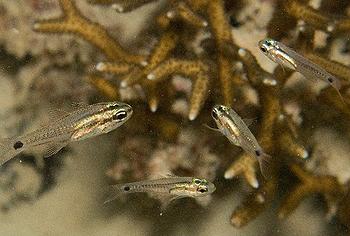
TOWNSVILLE, Queensland, Australia, July 8, 2013 (ENS) – Young coral reef fishes find their way back to the reef of their birth using the Sun and an internal body clock to steer by, an international team of marine scientists has discovered.
The tiny fish, no more than a few millimeters in length, avoid getting lost and eaten in the ocean and navigate their way to safety using what the researchers are calling a “sun compass.”
When fish hatch on a reef they are swept away by currents into the open ocean. Then these tiny creatures must find their way back to the home reef, or another nearby, where they can settle in safety, explains Professor Mike Kingsford of the ARC Centre of Excellence for Coral Reef Studies and James Cook University.

“Failure to get back to a reef spells death for baby fish, and we’ve known for some time that they use their senses of hearing and smell to locate the reef and head back to it,” said Kingsford.
“The fact that we’ve shown they also have a Sun compass in their tiny heads and can orient themselves according to the Sun’s position through the day provides the missing link in their navigational toolkit,” he says.
The fish with which the researchers tested their theory were four-line cardinal fish, Ostorhinchus doederleini, which are widespread in the Western Pacific, from Taiwan to the Kermadec Islands and from Japan to Australia.
They performed their tests using a small plastic swimming pool and baby cardinal fishes at One Tree Island on Australia’s Great Barrier Reef. In a matter of seconds the juvenile cardinal fish turned and headed in a south southeasterly direction – and kept on heading that way even when the researchers turned their pool.
“The currents that sweep the baby fish off the reef generally set in a north-northwesterly direction, so to get back to it the fish have to swim south-southeast. The big question was: how did they know where that point of the compass lay, and keep to it?” Kingsford says.
“Though smaller than a good many insects, baby fish are surprisingly strong swimmers and they can push up against the current for several days, covering distances of twenty kilometers or even more,” he said. “The mystery was how they maintained a correct orientation during this life-or-death journey.”
To test their reliance on the Sun, the researchers “clock shifted” the little fish six hours back in time. They did this by putting the fish in a dark room and using artificial lights to reset their body clocks to a time six hours earlier.

The fish were fooled by the position of the Sun and began automatically to swim in an opposite direction – to the north-northwest.
“Since they are swept too far from the home reef to smell or hear it, this provides strong evidence they steer mainly by the Sun, making compensatory allowances as it moves across the sky,” said Kingsford.
“This is a complicated task which quite a few humans would struggle to perform,” said Kingsford, “but which baby coral reef fish seem to accomplish with few difficulties.”
The researchers tested the fishes’ orientation on both sunny and cloudy days, finding that they were more precise in their navigation when the Sun was out. They found the fishes’ directional instincts were at their weakest around noon when the Sun was directly overhead, providing less information to steer by.
“The tests … demonstrate that the fish have an internal clock that they use as part of a time-compensated sun compass to maintain their south-southeast heading,” the researchers conclude in their published paper.
“Since the time-compensation required for a sun compass needs to be learned (because the exact movement of the sun varies greatly with season and latitude),” the researchers conclude, “it is likely that this learning takes place during the early dispersal phase.” (ie. soon after the fish larvae drift off their home reef.)”
They note that certain birds and sea turtles are born with an in-built sense of direction, and it is possible the baby cardinal fish, too, inherit the instinct to head south-southeast – back towards their home reef.
Their paper “Sun Compass Orientation Helps Coral Reef Fish Larvae Return to Their Natal Reef” by Henrik Mouritsen, Jelle Atema, Michael J. Kingsford and Gabriele Gerlach appears in the open access journal “PLOS One” of June 2013.
Copyright Environment News Service (ENS) 2013. All rights reserved.
© 2013, Environment News Service. All rights reserved. Content may be quoted only with proper attribution and a direct link to the original article. Full reproduction is prohibited.
